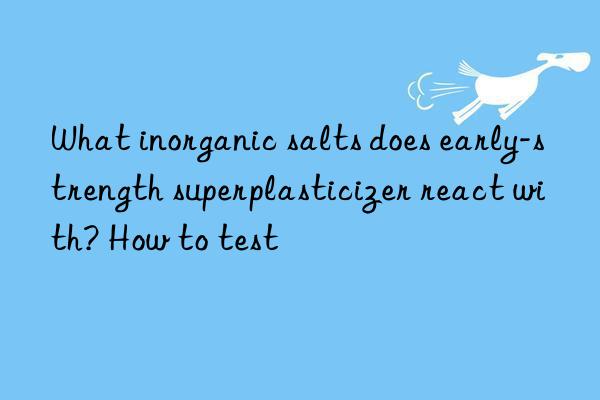
Early strength is a high molecular polymer and has a very stable structure. Under normal circumstances, it will not react with inorganic salts. What affects your water reduction rate should be that your inorganic salts react with substances in the cement, accelerating the early hydration of the cement. The resulting state seems to affect the water reduction rate.
The early-strength water-reducing agent content is low and the water-reducing rate is high;
The slump loss over time is small;
The reinforcing effect is significant, and the concrete 3d resistance The compressive strength is increased by 50-110%, the 28-day compressive strength is increased by 40-80%, and the 90-day compressive strength is increased by 30-60%;
The concrete has excellent workability, no segregation or bleeding, and the appearance of the concrete Uniform color;
When used to prepare high-grade concrete, the concrete has good cohesion and is easy to stir;
It has moderate air content, has no adverse effect on the elastic modulus of concrete, and is frost-resistant and durable. Good adaptability;
Can reduce the early hydration heat of cement, which is beneficial to large-volume concrete and summer construction;
Excellent adaptability, good compatibility of cement and admixtures, and temperature adaptability Good resistance;
Low shrinkage, which can significantly reduce the shrinkage of concrete, and its freeze-thaw resistance and carbonation resistance are significantly better than ordinary concrete;
Significantly improve the volume stability and long-term durability of concrete ;
The alkali content is extremely low, alkali content ≤0.2%, which can effectively prevent the occurrence of alkali aggregate reaction;
The product has good stability, and there is no stratification or precipitation during long-term storage occurs, and there is no crystallization at low temperatures;
The product is green and environmentally friendly, does not contain formaldehyde, and is an environmentally friendly product;
It has good economic benefits and the overall project cost is lower than other types of products. Under the same strength conditions, 15-25% of cement can be saved.
The concrete ratio for testing water reduction rate is not the C30 concrete ratio. Measuring water reduction rate has nothing to do with concrete strength. If you have read the specifications
Mix ratio
The benchmark concrete mix proportion is designed according to JGJ55. The proportions of cement, sand and stone in the tested concrete mixed with non-air-entraining admixtures are the same as those in the corresponding benchmark concrete. The mix proportion design should comply with the following regulations:
a) Cement dosage: The unit cement dosage of the benchmark concrete and the tested concrete mixed with high-performance early-strength water-reducing agent or pumping agent is 360kg/m3; The unit cement dosage of the benchmark concrete and tested concrete for admixtures is 330kg/m3.
b) Sand rate: The sand rate of the benchmark concrete mixed with high-performance water reducing agent or pumping agent and the tested concrete are 43% to 47%; the sand rate of the benchmark concrete mixed with other admixtures and the tested concrete The sand rate of concrete is 36% to 40%; however, the sand rate of the tested concrete mixed with air-entraining water-reducing agent or air-entraining agent should be 1% to 3% lower than the sand rate of the benchmark concrete.
c) Additive dosage: According to the dosage specified by the manufacturer.
d) Water consumption: The slump of the reference concrete and the tested concrete mixed with high-performance water-reducing agent or pumping agent is controlled at (210±10) mm,
Early The water consumption of strong water-reducing agent is the minimum water consumption when the slump is (210±10)mm; the slump of the benchmark concrete and tested concrete mixed with other admixtures is controlled at (80±10)mm. Water consumption includes the amount of water contained in liquid admixtures, sand, and stone materials
</p



 微信扫一扫打赏
微信扫一扫打赏
